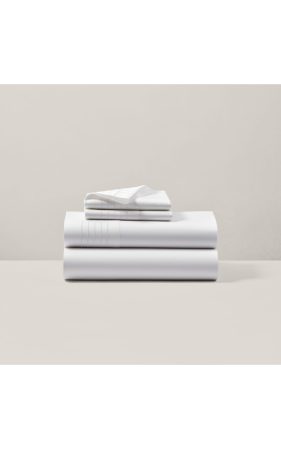We may earn revenue from the products available on this page and participate in affiliate programs.
You can’t properly discuss bed linens without answering the ultimate question: What is a good thread count for sheets? Generally speaking, people tend to assume value and a high thread count go hand in hand, but the answer isn’t as straightforward as you’d think. If all factors are created equal—we’re talking construction, nature of fabric, and finishes—then yes, higher definitely equals better. As it turns out, there’s a catch. To answer this burning bedding query, we broke down the definition of thread count and tapped a few designers to weigh in on how to spot quality sheet sets.
What Does Thread Count Even Mean?
Simply put, thread count measures the number of threads, both horizontal and vertical, that a fabric contains per each square inch. The higher the number of threads, the tighter the yarns are woven together—and the more velvety they’ll be to the touch. Oftentimes you’ll see a sheet’s thread count range anywhere from 200 to 600, though occasionally numbers tip over 1,000. Pro tip: Check whether the sheets you are considering are single- or multi-ply—in the latter case, the thread count is the total of all the fabric layers together. For example, a single-ply sheet with a 300 thread count would be considered a 600 thread count if it were double-ply, which is nothing more than a misleading marketing ploy.
Is It True That the Higher the Thread Count, the Better?
“The most important element leading to more luxurious fabric is the quality of the yarn,” says George Matouk Jr., CEO of heritage linens brand Matouk. So what is a good thread count for sheets? Well, with so many variables in the mix, Matouk couldn’t really recommend one number over another on its own. “Some 1,000-thread-count fabrics are sublime and others are lousy,” he notes.
Much like sunscreen SPF, once you reach a certain thread count—500 to be exact—you’re not getting that much more bang for your buck. Single-ply sheets ranging anywhere between 300 to 500 is the sweet spot, with numbers below 300 tending to be a bit coarse or scratchy. Anything above 500 is likely inflated due to that multi-ply trick. P.S.: Hot sleepers should be especially wary of a too-high thread count, since that could also mean the fabric is denser and air won’t flow through it as well.
Aside From Thread Count, What Should You Look for in Good Sheets?
Egyptian, pima, and Supima cotton are often considered your best options. Some people like a lighter, breathable weave, such as percale (which has a matte finish), while others prefer a heavier fabric like sateen (a shinier look) or flannel (think: your favorite button-down). Linen, made of flax rather than cotton, is also having a moment lately. One perk: It gets softer with every wash. But no matter what you choose, be sure to consider the length of the fiber. The longer it is, the softer the feel.
Searching for the most luxurious sheets? Here are our faves:
Three Designers’ Takes on What Is a Good Thread Count for Sheets

We asked three professionals—interior designers Leanne Ford and Robert McKinley and Hill House Home founder Nell Diamond—what they look for when buying bedding.
Focus on Fabric
Ignore thread count—that’s old news. It’s all about the feel of the material you choose for your sheets. Cotton sheets are the definition of rest easy. They’re supersoft, like you’ve had them forever; 100 percent sleepable; and even cozier when you get them in a palette of modern neutrals.
Linen sheets are beyond light and incredibly airy. They look best a little rumpled. Let me rephrase that: They look best very rumpled! They are 100 percent comfortable, and again they’re most relaxing when in a palette of modern neutrals. —Leanne Ford
Check All the Boxes
Thread count is typically an unreliable metric for determining the value of bedding, and in my experience, the way thread count is reported varies across brands. I like to focus on design, style, and fabric type. If I were looking for something crisp and cool, I would go with Hill House Home’s Chancery Lane sheets, which are made from 100 percent cotton percale. Alternatively, if I were looking for something with a softer and more luxurious feel, I would go with our Savile sheets, which are made from 100 percent brushed cotton sateen. —Nell Diamond
Shop Small
I’ve used bedding from Wright in all of my Bungalow projects. They are a perfect example of high quality and comfort. Wright’s cotton and linen sheets are 100 percent American-made, and the brand works with small mills to source its materials. I always try to source locally when I can, so I love working with a company that supports smaller makers.
For cotton sheets, I recommend a 250 thread count for a cool, crisp, hotel feel. It’s important to pay attention to the type of cotton as well; Wright uses American Supima cotton, which gives the sheets greater durability, resulting in less pilling or fading. I love using linen sheets for our projects in Montauk, New York. The material is naturally soft and cool, which is great for the summer months. Good linen bedding should have a weave of a full 8 ounces per square yard in order to get the perfect combination of softness and texture. —Robert McKinley
The Goods
Organic Cotton Sateen Handkerchief Sheet
Ralph Lauren HomePastel Trellis Top Sheet
Hill House HomeScallop Sheet Set
Serena u0026 LilyOrganic Cotton Tattersall Sheeting
Ralph Lauren Home








